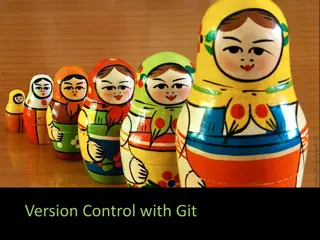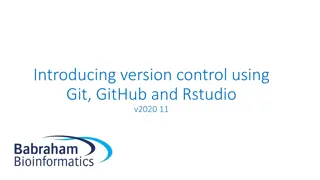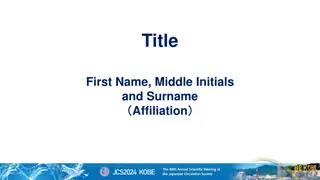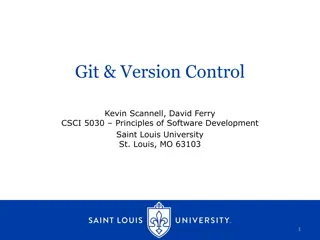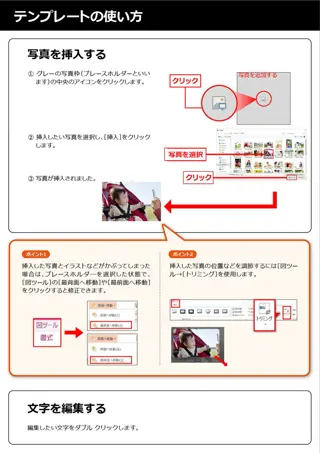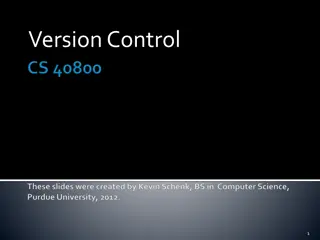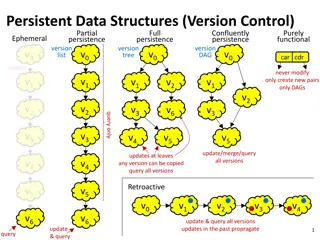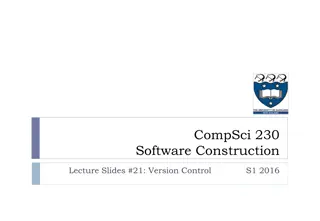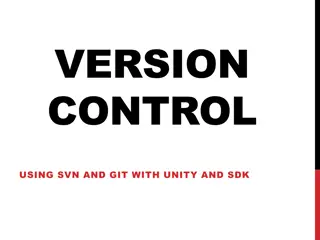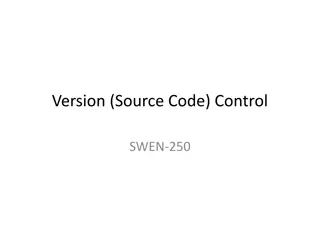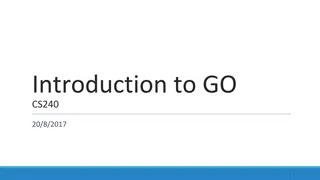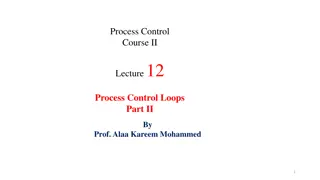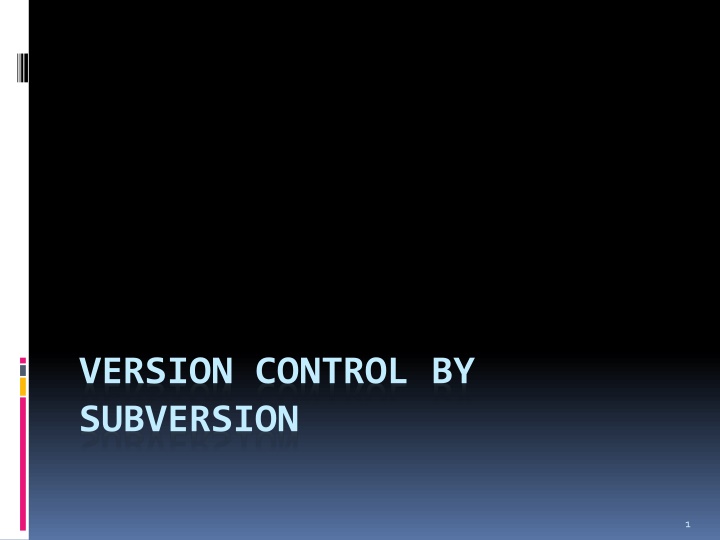
Version Control and Software Configuration Management
Explore the concepts of centralised and distributed Software Configuration Management (SCM) and the role of tools like Subversion and Mercurial. Learn how version control systems address file sharing problems through different models like Lock-Modify-Unlock. Discover the significance of Subversion repositories in tracking every change made to files and directories.
Download Presentation

Please find below an Image/Link to download the presentation.
The content on the website is provided AS IS for your information and personal use only. It may not be sold, licensed, or shared on other websites without obtaining consent from the author. If you encounter any issues during the download, it is possible that the publisher has removed the file from their server.
You are allowed to download the files provided on this website for personal or commercial use, subject to the condition that they are used lawfully. All files are the property of their respective owners.
The content on the website is provided AS IS for your information and personal use only. It may not be sold, licensed, or shared on other websites without obtaining consent from the author.
E N D
Presentation Transcript
VERSION CONTROL BY SUBVERSION 1
SCM (software configuration management) Centralised SCM A centralised SCM stores all of its metadata in a single authoritative (or "master") database that is not replicated (except possibly for backup purposes). CVS (and RCS and SCCS) follows this model, as does Subversion. 2
Distributed SCM A distributed SCM tool (abbreviated: a DSCM tool) is designed to support a model in which each repository is loosely coupled to many others. Each repository contains a complete set of metadata describing one or more projects. These repositories may be located almost anywhere. Individual developers only need access to their own repositories, not to a central one, in order to commit changes. Distributed SCMs provide mechanisms for propagating changes between repositories. Distributed SCMs are in contrast to centralised SCMs. Mercurial is a DSCM. 3
The Repository Subversion is a centralized system for sharing information. At its core is a repository, which is a central store of data. 5
What is interesting this sounds like the definition of a typical file server? What makes the Subversion repository special is that it remembers every changeever written to it: every change to every file, and even changes to the directory tree itself, such as the addition, deletion, and rearrangement of files and directories. 6
Versioning Models The Problems of File sharing 7
The Lock-Modify-Unlock Solution Many version control systems use a lock- modify-unlockmodel to address this problem 8
The problem of lock-modify- unlock model Locking may cause administrative problems. Sometimes Harry will lock a file and then forget about it. Meanwhile, because Sally is still waiting to edit the file, her hands are tied. And then Harry goes on vacation. Now Sally has to get an administrator to release Harry'slock. The situation ends up causing a lot of unnecessary delay and wasted time. Locking may cause unnecessary serialization.What if Harry is editing the beginning of a text file, and Sally simply wants to edit the end of the same file? These changes don't overlap at all. They could easily edit the file simultaneously, and no great harm would come, assuming the changes were properly merged together. There's no need for them to take turns in this situation. Locking may create a false sense of security.Pretend that Harry locks and edits file A, while Sally simultaneously locks and edits file B. But suppose that A and B depend on one another, and the changes made to each are semantically incompatible. Suddenly A and B don't work together anymore. The locking system was powerless to prevent the problem -yet it somehow provided a sense of false security. It's easy for Harry and Sally to imagine that by locking files, each is beginning a safe, insulated task, and thus inhibits them from discussing their incompatible changes early on. 9
The Copy-Modify-Merge solution Subversion, CVS, and other version control systems use a copy-modify-merge model as an alternative to locking. In this model, each user's client reads the repository and creates a personal working copy of the file or project. Users then work in parallel, modifying their private copies. Finally, the private copies are merged together into a new, final version. The version control system often assists with the merging, but ultimately a human being is responsible for making it happen correctly. 10
Conflicts But what if Sally's changes do overlap with Harry's changes? What then? This situation is called a conflict, and it's usually not much of a problem. When Harry asks his client to merge the latest repository changes into his working copy, his copy of file A is somehow flagged as being in a state of conflict: he'll be able to see both sets of conflicting changes, and manually choose between them. Note that software can't automatically resolve conflicts; only humans are capable of understanding and making the necessary intelligent choices. Once Harry has manually resolved the overlapping changes (perhaps by discussing the conflict with Sally!), he can safely save the merged file back to the repository. 12
The advantage of copy- modify-merge model The copy-modify-merge model may sound a bit chaotic, but in practice, it runs extremely smoothly. Users can work in parallel, never waiting for one another. When they work on the same files, it turns out that most of their concurrent changes don't overlap at all; conflicts are infrequent. And the amount of time it takes to resolve conflicts is far less than the time lost by a locking system. 13
Working copy (test) A Subversion working copy is an ordinary directory tree on your local system, containing a collection of files. You can edit these files however you wish, and if they're source code files, you can compile your program from them in the usual way. Your working copy is your own private work area: Subversion will never incorporate other people's changes, nor make your own changes available to others, until you explicitly tell it to do so. 14
To checkout and commit To get a working copy, you must check out some subtreeof the repository. (The term check out may sound like it has something to do with locking or reserving resources, but it doesn't; it simply creates a private copy of the project for you). To publish your changes to others, you can use Subversion's commit command. 15
Practical rules Do not commit binary files such as .obj .dll Do not commit debugging information files These files can be large which make checkout and commit inefficient Keep pure source code 16
Revisions Each time the repository accepts a commit, this creates a new state of the filesystemtree, called a revision. Each revision is assigned a unique natural number, one greater than the number of the previous revision. The initial revision of a freshly created repository is numbered zero, and consists of nothing but an empty root directory 17
In a version control system You never need to worry about some files are messed up and do not have a backup You can retrieve any revision you want. 19
Global Revision Numbers Unlike those of many other version control systems, Subversion's revision numbers apply to entire trees, not individual files. Each revision number selects an entire tree, a particular state of the repository after some committed change. Another way to think about it is that revision N represents the state of the repository filesystem after the Nth commit. When a Subversion user talks about ``revision 5 of foo.c'', they really mean ``foo.c as it appears in revision 5.'' Notice that in general, revisions N and M of a file do notnecessarily differ! 20
Lets begin an example Add Checkout Commit 21
Conflict() conflict commit
Conflict() Fred Wilma File1.java Fred commit Wilma commit File1.java working copy File1.java working copy working copy commit Fred Wilma Wilma
Branching / Tagging One of the features of version control systems is the ability to isolate changes onto a separate line of development. This line is known as a branch. 25
Trunk/Branches trunk debug, trunk subversion trunk trunk branch coding Save your temporary files to your branch Make sure your programmer accustomed to such usage. Programmer may carelessly delete files and lost days of work. Which is stupid ! But it happens from time to time when programmers do not commit files often. Force them to commit file, you can do code review as earlier as possible. 26
Merging Where branches are used to maintain separate lines of development, at some stage you will want to merge the changes made on one branch back into the trunk, or vice versa. It is important to understand how branching and merging works in Subversion before you start using it, as it can become quite complex. 28
Reintegrate a branch Figure 4.37.The Merge Wizard - Reintegrate Merge To merge a feature branch back into the trunk you must start the merge wizard from within a working copy of the trunk. In the From URL: field enter the full folder URL of the branch that you want to merge back. You may also click ... to browse the repository. There are some conditions which apply to a reintegrate merge. Firstly, the server must support merge tracking. (> version 1.5.0) The working copy must be of depth infinite (no sparse checkouts), and it must not have any local modifications, switched items or items that have been updated to revisions other than HEAD. All changes to trunk made during branch development must have been merged across to the branch (or marked as having been merged). The range of revisions to merge will be calculated automatically. 30
Reviewing the Merge Results The merge is now complete. It's a good idea to have a look at the merge and see if it's as expected. Merging is usually quite complicated. Conflicts often arise if the branch has drifted far from the trunk. 31
Exporting a Subversion Working Copy Sometimes you may want a copy of your working tree without any of those .svn directories, e.g. to create a zipped tarball of your source, or to export to a web server. Instead of making a copy and then deleting all those .svndirectories manually, TortoiseSVNoffers the command TortoiseSVN Export.... Exporting from a URL and exporting from a working copy are treated slightly differently. 33
Mercurial http://mercurial.selenic.com/wiki/Understand ingMercurial 34



